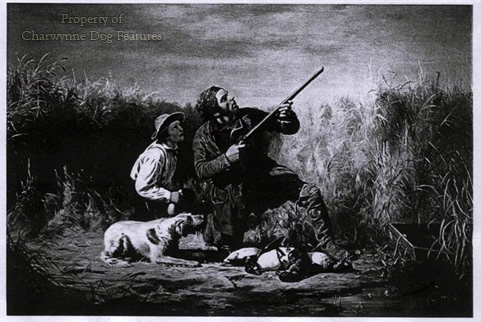714 GUNDOGS-BEFORE THERE WERE GUNS
GUNDOGS - BEFORE THERE WERE GUNS
by David Hancock
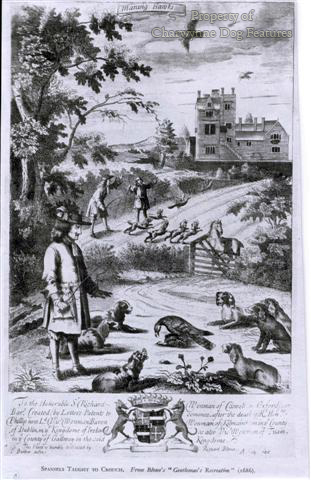
 Strictly speaking, once you have named a distinct group of dogs as ‘gundogs’, their history begins with the invention of firearms. But hunters were ‘armed’ long before the introduction of firearms, with the spear, the bow and arrow, the boar-lance and the bolt-firing weapons to the fore. The net could also be described as a weapon, being used to capture rabbits or envelop game birds indicated by setters or pointers. Before the invention of firearms, hunters were reliant on dogs which could indicate unseen game and not run-in, as well as those which could retrieve valuable bolts, especially from water, when used on wild fowl.
Strictly speaking, once you have named a distinct group of dogs as ‘gundogs’, their history begins with the invention of firearms. But hunters were ‘armed’ long before the introduction of firearms, with the spear, the bow and arrow, the boar-lance and the bolt-firing weapons to the fore. The net could also be described as a weapon, being used to capture rabbits or envelop game birds indicated by setters or pointers. Before the invention of firearms, hunters were reliant on dogs which could indicate unseen game and not run-in, as well as those which could retrieve valuable bolts, especially from water, when used on wild fowl.
In the late middle ages, the netting of birds was not a simple matter; dogs had to be trained to find the quarry and ‘hold’ them whilst crouching expectantly but with immense patience. To further deter the birds from taking off, a kite-hawk, a device resembling a bird of prey, would be flown over them. Alternatively, a falcon could be positioned above them, either flown free or at the top of a long pole, within sight of the birds. Each stratagem ensured the birds clung to the ground, so enabling the hunter to proceed. Once the targeted, transfixed birds were grounded by this system, the netsmen could advance with their net, trail it over the prone dog and cast it over the stupified birds. Gamekeepers would often spread obstacles in open fields to prevent game being poached in this manner.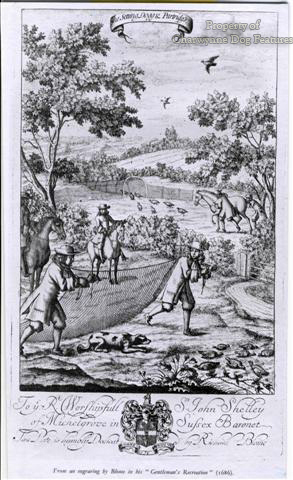
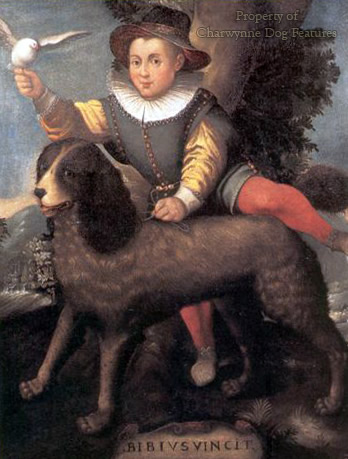
Shooting birds with a gun was initially regarded as pot-filling rather than sport. The sporting way was locating them with ‘setting dogs’ which then lay low to allow the hunters’ net to be drawn over both them and the crouching dogs or chiens couchant. There are many setters to this day which instinctively crouch low rather than stand and point in the classic pose. In continental Europe a draw-net or tirasse was employed; this involved the dogs crawling slowly towards the stationary birds, gradually driving the alarmed but not yet flight-prone birds towards the approaching netsmen. In such a way, the dogs ‘worked’ the birds into the net, rather as a well-trained collie urges sheep to move but not run. The value to the hunter, both here and on the continent, of a dog which instinctively found game on the ground, indicated its find, then almost hypnotised it into staying on the ground until a net descended on it, must have been priceless.
The rapport between sportsman and setting dog was captured in The Sportsman’s Cabinet of 1803, with these words: “That the setting dog has more continual and intimate relations with man, than almost any other of the species; he hunts within his view, and almost under his hand; his master affords him pleasure, for the pleasure is mutual when the game is in the net; which being shown to the dog, he is caressed if he has done right, corrected if he has done wrong; his joy in the first instance, or his remorse in the latter, are equally apparent, and in this mutual gratification is formed the very basis of reciprocal affection.” We may well have lost that particular intimacy with our gundogs as operating distances increased with developing shooting methods.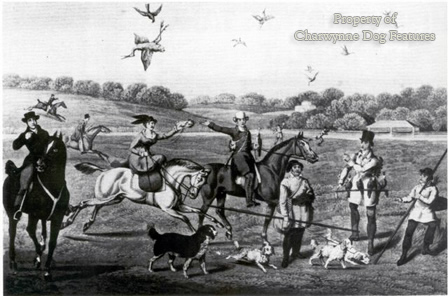
I am inclined to believe that the earliest sporting dogs, other than hounds of the chase, were the dogs ‘da rete’ (of the net) and the water dogs that would retrieve bolts, arrows and wildfowl which had fallen into water. The ‘oysel’ or bird dogs of the 16th century were much more setter-like than anything else. I take the view that the expression chiens d’arret or stop-dogs is more likely a corruption of chiens de rets; the French word ‘rets’ meaning a net or a snare. Terms like chien couchant, chien d’oysel and chiens de rets were used for dogs working to the net before the distinct breeds for this task evolved. In his The Master of Game of 1410, Edward, Duke of York, called all bird dogs spaniels but pointed out that some could be trained for the net, referring to them as ‘couchers’.
In his ground-breaking book Of English Dogs of 1576, the Cambridge scholar Dr Caius was recording: “When he hath found the bird, he keepeth sure and fast silence, he stayeth his steps and will proceed no further; and with a close, covert and watching eye, layeth his belly to the ground, and so creepeth forward like a worm…whereby it is supposed that this kind of dog is called Index, ‘Setter’, being indeed a name most consonant and agreeable to his quality.” Half a century later, Gervase Markham was writing: “It is meete that first before I wade further into this discourse, I shew you, what a Setting dogge is: you shall then understand that a Setting Dogge is a certaine lusty land spaniel, taught by nature to hunt the partridges, before, and more than any other chase.” He also referred to the taking of pheasants by bird-liming bushes, supported by spaniels.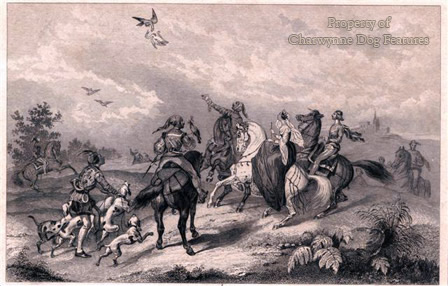
Spaniels were used too with the net and the hawk. The use of names for types and uses of dogs was more than loose in past times. The Irish called the setter the English Spaniel for quite some time, the poet Gay referred to the setter as ‘the creeping spaniel’. All longer or rougher-haired sporting dogs, not used as hounds, were once clubbed together as spaniels. The cocking spaniel was also called the gun spaniel. In his Rural Sports of 1870, Delabere Blaine disputes a Captain Brown’s statement that “The true English-bred spaniel differs but little in figure from the setter, except in size”, writing that “It is evident Captain Brown here thought only of the large sporting spaniel. Both springers and cockers are used in greyhound coursing, and the excellent scenting qualities of each usually enables them to find every hare in their beat.”
Nicholas Cox, in 1677, was stressing the value of the spaniel in hawking, writing: “How necessary a thing it (i.e. the spaniel) is to falconry I think nobody need question, as well as to spring and retrieve a fowl being flown to the mark, and also in divers and other ways to help and assist falcons and goshawks.” But was he writing of spaniels or setters or even, before the days of pure-breeding, of a blend of the two? The veracity of sources matters too; Dr Caius was a scholar not a sportsman and undoubtedly had his leg pulled by the latter; Cox was a shameless plagiarist who used material on French dogs as arising from here; Markham was a clever and prolific journalist who often wrote beyond his knowledge.
 But when real sportsmen write you soon get a marvellous impression of the essence of the sport itself. In an article headed ‘The Setter and Grouse’, ‘Nimrod’ in a sporting magazine of 1837, described the practice of an old-fashioned squire in Flintshire, Peter Davies of Broughton Hall: “The old gentleman took the field in good style, being accompanied by a servant to hold his horse when he dismounted, and two mounted keepers in their green plush jackets and gold-laced hats. A leash of highly-bred red and white setters were let loose at a time, and beautifully did they range the fields, quartering the ground in obedience to the voice or whistle. On the game being found, every dog was down, with his belly close on the ground; and the net being unfurled, the keepers advanced on a gentle trot, at a certain distance from each other, and drew it over them and the covey at the same time. Choice was then made of the finest birds, which were carried home alive, and kept in a room till wanted, and occasionally all would be let fly again, on ascertaining their fitness for the spit. Modern sportsmen may consider this tame sport, and so in fact it is, compared with the excitement attending the gun; but still it has its advantages. It was the means of preserving game on an estate, by equalising the number of cock and hen birds – at least to an extent – and killing the old ones; no birds were destroyed but what were fit for eating; and such as were destroyed, were put to death at once, without the chance of lingering from the effects of a wound, which is a circumstance inseparable from shooting.” Sounds like ethically-acceptable sport to me, awaiting a come-back.
But when real sportsmen write you soon get a marvellous impression of the essence of the sport itself. In an article headed ‘The Setter and Grouse’, ‘Nimrod’ in a sporting magazine of 1837, described the practice of an old-fashioned squire in Flintshire, Peter Davies of Broughton Hall: “The old gentleman took the field in good style, being accompanied by a servant to hold his horse when he dismounted, and two mounted keepers in their green plush jackets and gold-laced hats. A leash of highly-bred red and white setters were let loose at a time, and beautifully did they range the fields, quartering the ground in obedience to the voice or whistle. On the game being found, every dog was down, with his belly close on the ground; and the net being unfurled, the keepers advanced on a gentle trot, at a certain distance from each other, and drew it over them and the covey at the same time. Choice was then made of the finest birds, which were carried home alive, and kept in a room till wanted, and occasionally all would be let fly again, on ascertaining their fitness for the spit. Modern sportsmen may consider this tame sport, and so in fact it is, compared with the excitement attending the gun; but still it has its advantages. It was the means of preserving game on an estate, by equalising the number of cock and hen birds – at least to an extent – and killing the old ones; no birds were destroyed but what were fit for eating; and such as were destroyed, were put to death at once, without the chance of lingering from the effects of a wound, which is a circumstance inseparable from shooting.” Sounds like ethically-acceptable sport to me, awaiting a come-back.
A number of old books on sporting dogs describe the setter as the fowler’s dog and link the pointer breeds only with the introduction of firearms. In the 17th century on the continent and in the early 18th century in England, the braques and pointing griffons were developed, probably benefiting from the blood of the hounds, like the bracke and the scenthound griffons (or Gayffons as Markham misnamed them in 1630) in central Europe. In England, the setter breeds and the Pointer developed separate loyal bands of devotees, with the Rev Simons writing in 1776: “The setter cannot be degraded into a pointer; but the pointer may be elevated to a setter, though but a second class. The setter is only of service where there is room to run a net, so must be hunted accordingly. Whole coveys are the just attention of the setter...The pointer as has been the setter, is broke from chasing we well suppose, to which the sight of the game had hitherto been the stimulus. Now, although he will hear the whirl and departure of the birds it is more than probable the report of the gun will agitate him into the forgetfulness of duty and the urge to pursue.” Gundogs had arrived.
